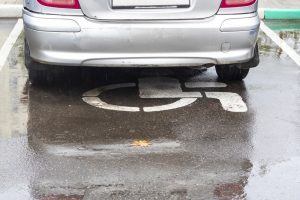In 2022, 60% of disabled adults in England aged 17 and older held a full driving license, while the percentage was 79% for non-disabled adults in the same age group. Driving aids are an essential innovation that enhances accessibility and safety for drivers, particularly those with limited mobility or unique needs. From steering aids to hand controls, car driving aids offer tailored solutions to improve driving comfort and control. However, with these adaptations come questions about safety, effectiveness, and the impact they have on the overall driving experience.

What Are Driving Aids?
Driving aids are devices or adaptations installed in vehicles to assist drivers in operating their cars safely and efficiently. These aids range from simple pedal extensions to advanced control devices that replace traditional driving mechanisms. They are invaluable for individuals with limited mobility, those adapting to a disability, or even drivers seeking to enhance their overall driving experience.
Types of Driving Aids
1. Primary Driving Aids
These include adaptations to the main controls of the vehicle, such as the accelerator, brake, and steering wheel. Examples include:
- Hand controls: Allow drivers to accelerate and brake using their hands rather than feet.
- Left-foot accelerators: Ideal for those who cannot use their right foot.
- Pedal adaptations: Modify pedal positions for easier access.
2. Secondary Driving Aids
These aids manage secondary controls like indicators, headlights, and wipers. Examples include:
- Remote control devices: Enable operation of multiple functions from one location.
- Steering wheel-mounted switches: Offer easy access to essential controls.
3. Steering Aids
Steering aids, such as spinner knobs or steering balls, make turning the wheel easier for those with limited hand strength or dexterity.
How Safe Are Driving Aids?
1. Testing and Certification
Driving aids, especially those installed for drivers with disabilities, undergo rigorous testing to meet safety and regulatory standards. Certified professionals must install these devices to ensure they integrate seamlessly with the vehicle’s systems.
2. Adaptability to Drivers’ Needs
Safety is maximised when driving aids are tailored to the individual. Aids including hand controls, pedal adaptations, or steering aids should match the driver’s unique requirements to ensure control and comfort.
3. Driving Confidence
Driving aids can significantly improve confidence, especially for drivers with limited mobility or disabilities. Confidence translates to safer driving behaviour, as drivers feel more in control of their vehicles.
4. Vehicle Adaptations
Properly installed vehicle adaptations do not compromise the car’s structural integrity or performance. For instance, a hand control system for accelerating and braking operates independently of the foot pedals, ensuring redundancy and safety.
The Role of Driving Aids in Enhancing Safety
1. Improved Accessibility
Driving aids make it possible for individuals with physical limitations to drive independently. This reduces reliance on public transport or assistance, promoting autonomy and safety on the road.
2. Reduced Fatigue
Drivers with disabilities often expend more energy operating standard vehicle controls. Aids such as steering wheels with additional grips or hand controls reduce fatigue, leading to safer, more focused driving.
3. Increased Reaction Times
Tailored driving aids optimise the positioning and operation of controls, which can improve reaction times in critical situations. For instance, a left-foot accelerator ensures quicker responses for drivers who cannot use their right foot.
Common Concerns About Driving Aids
1. Compatibility Issues
Not all vehicles are compatible with every type of driving aid. For safety, it’s essential to consult professionals to ensure the chosen adaptation works seamlessly with the car’s make and model.
2. Learning Curve
While driving aids are designed to make driving easier, they often require practice to master. Drivers should allocate time to get accustomed to their adapted vehicles before hitting the road.
3. Cost of Installation
High-quality driving aids and professional installation can be costly. However, many regions, including the UK, offer grants or funding options to help cover these expenses.
4. Maintenance and Repairs
Driving aids may require periodic maintenance to remain functional and safe. This adds an extra layer of responsibility for the driver.
Legal and Insurance Considerations in the UK
1. Driver’s Medical Declaration
UK law requires drivers to inform the DVLA of any medical conditions or disabilities that could affect their ability to drive. Driving aids are often a part of the solution to regain or maintain a licence.
2. Driving Tests for Adapted Vehicles
If a vehicle has been significantly modified, drivers may need to pass a driving test in the adapted car to prove their competence.
3. Insurance Implications
Insurance providers in the UK must be informed about any vehicle adaptations. While premiums may increase slightly, proper disclosure ensures claims are not invalidated in case of accidents.
Training and Support for Drivers Using Aids
1. Online video guides
These video guides offer tailored instruction on safely utilising driving aids, ensuring that the differently abled can effectively learn how to operate their vehicles.
2. Practice Sessions
Before venturing onto busy roads, drivers should practice in safe, controlled environments to build confidence with their new aids.
3. Ongoing Support
Manufacturers and suppliers of driving aids often offer support services, ensuring drivers can address any issues quickly.
Future of Driving Aids
1. Advances in Technology
As technology evolves, driving aids are becoming smarter and more integrated. For instance, voice-controlled secondary functions and adaptive steering systems are revolutionising vehicle adaptations.
2. Autonomous Vehicles
Self-driving technology holds immense potential for individuals with limited mobility. While full autonomy is still years away, semi-autonomous features, such as adaptive cruise control and lane-keeping assist, are already bridging the gap.
3. Sustainability in Adaptations
Eco-friendly materials and energy-efficient systems are being incorporated into modern driving aids, aligning with the UK’s focus on sustainability.
Driving aids are a testament to how technology can empower individuals and promote inclusivity. From hand controls to pedal adaptations, these devices are not only safe but also life-changing for drivers with unique needs. While there are considerations such as cost, learning curves, and maintenance, the benefits far outweigh the drawbacks.
Whether you’re exploring driving aids for yourself or a loved one, consulting professionals and investing in high-quality adaptations are crucial steps to ensure safety and comfort on the road. With continuous advancements, driving aids are set to become even more accessible and efficient, paving the way for a more inclusive driving experience in the UK.

Enter the new driving experience with PB Conversions
Discover the freedom and confidence that comes with expertly fitted driving aids from PB Conversions! Whether you need hand controls, or advanced steering aids, we offer a wide range of solutions tailored to meet your unique needs. Our team of specialists ensures safe, professional installation and personalised guidance to enhance your driving experience. Don’t let mobility challenges hold you back—explore our comprehensive selection of car adaptations designed for comfort and safety. Contact PB Conversions today for expert advice or to book a consultation. Your journey to effortless driving starts here!
Recently had my fourth vehicle adapted by Paul At Pb Conversions.always does a first class job and with first class service & always easy to deal with. Thanks for the great service Paul from you and your crew over the years.
Kiran was very helpful today explaining some of the issues I had with my hoist, and how to avoid them from happening again.
Dealt with the adaptations for my son's new motability vehicle - very friendly, efficient and helpful. Really pleased.
Very helpful and knowledgeable engineer, fast and efficient service
Thank you so much for all your advice, help and very professional job on adapting our car. Without your advice I would never have known to apply for a grant. You were excellent, thank again.
Due to my husband's condition we need a car with adaptions, we were advised by his paraplegic group to visit and this place is the best. Felt so relaxed talking about what we needed, all the staff were so friendly and so well informed, going above and beyond, especially Paul Berridge. I fully recommend this business. Honest and reliable. Thank you.
Staff are super super friendly, helpful, extremely informative and really nothing Paul & Co can’t do to any vehicle. PERFECTION is their middle name! Thank you so much for your outstanding service to me over the years and I look forward to using your company all my driving life.
Excellent work done on our car and very professional company. Great customer service and prompt response to emails.
I am very pleased with the left foot accelerator adaption. The communication with the team was excellent
Our second time of utilising PB Conversions and still as impressed with their skills and assistance! They listen to your needs, their aim is to get you mobile and ensure you are happy and safe. Fully recommend
Very happy with my Adaptations best company I have used
I recently had an under ring accelerator and hand brake fitted to my car and I am extremely pleased with it. All of the staff I spoke to were extremely knowledgeable and helpful, explaining exactly how they worked. I would have no hesitation in recommending this company for mobility assistance
I’ve been using PB Conversions for over 30 years and cannot fault their care and attention to detail with every adaptation I’ve needed. And if something isn’t quite right they quickly sort it. Truly professional and innovative service every time
I have used PB on 2 occasions and 2 different cars. I have found their staff efficient, caring and most pleasant to deal with. Their work on my vehicles has been completed on schedule, flawlessly, with no issues arising after 2 + years use
Very good work and customer service
As always a professional and with care job
Good and prompt adaptions fitted. Support offered and flexible. All staff were helpful and communicated
If you’re looking for 5⭐️ customer service and quality workmanship look no further. I was kept in the picture all the way through the build with photos and telephone calls. A date was set for completion and they delivered on that exact day. It was refreshing to deal with such a professional company. The personal emails from your staff made it a pleasurable experience which is hard to find these day!
Really speedy and flexible response from PBC to an emergency situation requiring hand controls being fitted to a new vehicle. I much appreciated their support
Always excellent service from PB conversions. They had fantastic knowledge of the adaption options available and whether they would fit
Friendly, first class, prompt and efficient service at a very competitive price. Would recommend the company to all.
Would you like an assessment?
If you are a disabled driver, or know a disabled driver in Bedfordshire, Hertfordshire, Buckinghamshire or Northamptonshire, please contact PB Conversions for a free no obligation quote to assess what products would benefit you.
